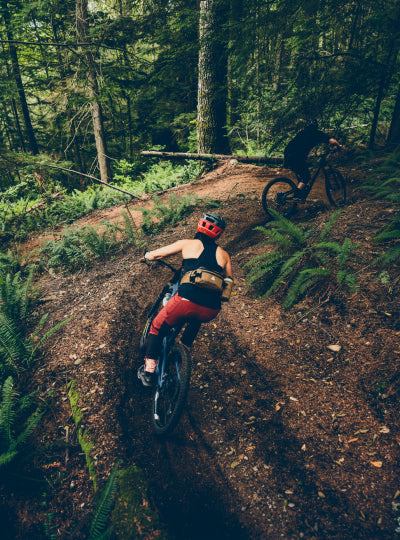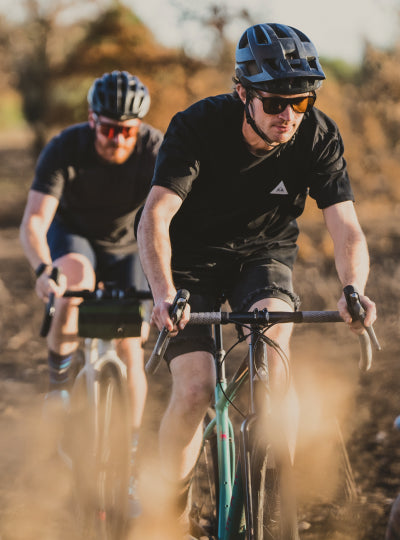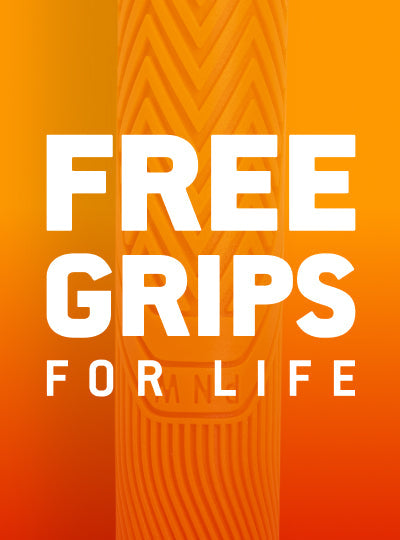When it comes to influential components on your bike, handlebars are often left out of the conversation despite their impact on how you ride. They dictate how you sit, stand, corner, jump, and do everything in between because they impact your posture and strength. Proper handlebar width is key to an optimized cockpit setup since it can impact your bike’s stability, maneuverability, and overall comfort. Getting the right fit is often a trial and error process of trimming your handlebars. To start, consider the build of your body, the geometry of your bike, and the type of trail you ride most. Read on for more detailed info about handlebar width, our recommendations, and advice from our experienced PNW Squad members.
Disclaimer: Cutting your handlebars is permanent. No amount of glue can reattach the trimmed pieces of your handlebars safely. If you trim your handlebars too much, you may end up needing to buy another pair.
Every Rider is Different
Every rider is different, so there is no “one-size-fits-all” equation for determining how wide your handlebars should be. Handlebar width is subjective and largely based on personal preference, but in general, riders who are taller, heavier, and have broader shoulders will likely need wider handlebars. The opposite can be said of riders with narrower shoulders and shorter arms. The proper handlebar width will allow you to get into the most efficient riding position where you can align your wrists, elbows, and shoulders and maintain control of your front wheel, so it’s important to tailor your bars to your body.
Note: Your lever placement will impact where you place your hands and how your cockpit feels. If you need advice on how to set up your cockpit, check out our guide on How to Set Up Your MTB Levers.

What Does Your Bike Like?
Like bodies, not all bikes are the same. Before making changes to your handlebar width, understand that the stated reach numbers of your bike are based on the manufacturer’s suggested stem and handlebar geometries. If you change your handlebar’s width, then you’ll also change how your bike rides. Making the switch to a narrower handlebar will wake up the front end of your bike making it more twitchy and easier to maneuver; while a wider bar will increase the stability of your front end and provide a calmer feel than before. If you don’t want to change how your bike handles the trail, counteract the new bar size by getting a longer stem if you’re trimming your bars, and getting a shorter stem if you’re increasing the width of your bars.
What Do You Ride?
The terrain you tackle on a regular basis also plays into your handlebar width preference. When riding XC singletrack, wider handlebars may not be in your best interest because they can make it difficult to handle tight corners or switchbacks, squeeze through small spaces, and slow your ability to quickly jump between different lines on the trail. If you’re looking to go over those obstacles, plow through rock gardens, and point straight down a steep section of trail, you’ll want something a bit wider. Wide handlebars will help you stay in control and keep your front wheel tracking in a straight line while roots and rocks do their best to push you off course.
What We Recommend
It’s best to be like Goldilocks and find the width that’s just right for you by starting with a wide bar and slowly trimming it down. This will allow you to find a width that encourages proper riding form and lets your bike handle as intended without taking too much off your bars at one time. If you’re using our Range Handlebars, use the demarcations on the bar ends to trim your bars in increments of 5mm until you find the ride feeling you’re looking for. Be sure to test your bike a few times after trimming your handlebars to really understand how they’ve impacted your ride before cutting them again.
Advice from the PNW Squad
Tired of hearing from us? Check out some of the recommendations from PNW Squad members Jon Allyn, Porsha Murdock, Dillon Lemarr, and Pat Smage on how to find the best handlebar width for you and then follow them on social media.
What is your preferred handlebar width?
Jon Allyn: 780 mm
Porsha Murdock: 760 mm
Dillon Lemarr: 800 mm for downhill, 780 mm for trail and dirt jumps.
Pat Smage: 770 mm
Does your preferred width change depending on what bike, or what type of trail, you’re riding?
Jon Allyn: For more aggressive riding I prefer a wider handlebar (780 mm to 800 mm), but for less aggressive trails, like XC, I would probably go with a 760 mm wide bar. Given my downhill background, I've become used to a wide, stable bar for descending and prioritize its advantages (stability) over disadvantages (maneuverability).
Porsha Murdock: For the most part I leave it around 750 mm to 760 mm. Predominantly because it’s comfortable for me.
Dillon Lemarr: Yes, I like 800 mm on my downhill bike for the added stability at higher speeds. I run 780 mm on my trail bike because a lot of time the trails are tighter and it’s a little more comfortable on the climbs. I run a 780 mm on my dirt jumper as well.
Pat Smage: Slightly, I like skinnier bars for tight single track with lots of close trees which is normal in the Midwest. But, I like wider bars for more open, steep, or fast trails that are common out West. 770 mm seems like a good compromise for my size. For now, anyway!

What are you looking for when determining your proper handlebar width?
Jon Allyn: Ideally you want to have your arms set up in the strongest position possible. The easiest way to measure this is by using the *push-up position method. Stem length also comes into play; typically, the longer your stem, the narrower you may want your bar width. This helps your body stay centered over the bike. If you’re running a stem that is 50 mm or less I'd suggest a 760 mm to 800 mm bar. If your stem is over 50mm, I'd start looking at bars less than 760mm wide.
*Jon uses the width of his hands while in this push up form to inform the approximate width of his handlebars.
Porsha Murdock: Mostly hand placement. If my bar is too wide, I start to get shoulder pain and if it’s too narrow it feels uncomfortable and awkward.
Dillon Lemarr: It’s all about being comfortable when you’re on your bike. I run a little narrower bar than most people my height because my legs are longer than my torso (6'3" and all leg, baby!). Bar width plays a huge role in cornering and if you’re running too wide of a bar for your body type you will not be able to properly angulate the bike and apply pressure down to the grips.
Pat Smage: I’m usually looking for a few things: riding position and how I feel over the bike, as well as leverage and balance.

Why is the answer to the previous question what you look for in handlebar width?
Jon Allyn: Stability is the main driver for my bar width choice. Anything that can help your confidence on the downhills is what I'm after. Other factors such as rise and backsweep come into play next which can really help dial in your comfort, or body positioning while riding.
Porsha Murdock: Having my hands in the correct placement (I typically have the end of my palm lined up with the end of the grip/bar) helps with reducing pain by allowing my arms to be in the correct positioning.
Dillon Lemarr: I think about the long term feeling of a bar. A certain bar might feel good for an hour or so, but how it feels after a full day and numerous hours on the bike is what I look at. There are several things a rider needs to consider in their cockpit to find optimal comfort such as grips, lever position, and seat height/position. The handlebar plays a huge role in that with proper width, back sweep, and rise. It’s all about trial and error, and you’ll soon find that sweet spot you’ve been looking for.
Pat Smage: I prioritize riding position so I can be comfortable on long rides. I don’t want to be leaned too far forward or back. By “feel over the bike” I mean I don’t want to feel like I’m behind the bike if the handlebars are too wide, or like I’m over the top of the bike if they’re too skinny. I want to feel like I’m “in” the bike to be connected to it in the right way. Wider bars seem to provide more leverage, balance, and stability but there is a limit depending on your height and style.
Do you have any additional advice for someone trying to find their preferred handlebar width?
Jon Allyn: Don't be afraid to try different bar widths. You should be able to tell after 1 or 2 rides if the bar width change was an improvement or not. I thought for the longest time 750 mm bars were perfect for me, then I tried both 800 mm and 780 mm bars and realized how much more stable I felt with that extra bar width. Little changes like this can have big impacts on your riding confidence.
Porsha Murdock: I typically put the bars on without brake levers or grips and grab the bars to see where I would naturally hold on. I’ll try it in various positions (seated/standing) and then I cut off the extra. This way my cut isn’t influenced by anything else other than comfort.
Dillon Lemarr: It may take a little time to find what you really like, so I suggest buying a wider bar and cutting it down as needed. If you start out with the bar a little wider than what you’re used to you may find that you really like it. If you feel you need to go shorter then you can always cut them down little by little. Remember, you can always cut the bar down shorter, but you can't put the width back on the bar.
Pat Smage: Start a bit wide and make small adjustments until you find what feels right. Try someone else’s handlebars that are skinnier before cutting yours, if possible. 5 mm may not sound like much to take off, but when it comes off of both ends it is quite a bit.
If you have questions regarding the article above, or any of our products, please reach out to our Customer Service team at info@pnwcomponents.com.






